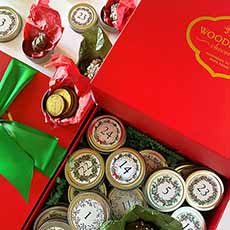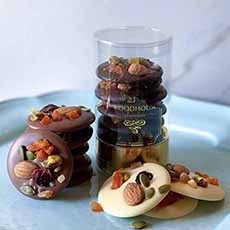CHRISTMAS GIFT: Advent Calendar From Woodhouse Chocolate
|
Order quickly if you want this wonderful “Advent calendar”: Only 150 sets were made (photo #1). Unlike the old-fashioned Advent calendar where little doors were opened to reveal the day’s treat (photo #3), Woodhouse Chocolate’s 2019 version puts each treat in a separate, reusable tin. Each tin contains a wonderful chocolate surprise: hand-decorated chocolate figures, filled chocolates, hot chocolates, barks and mendiants (photo #2). The red gift box contains 25 tins, one for each day from December 1st through Christmas. The high-end box, with a magnetic closure, can be (and should be!) repurposed. To celebrate the Advent and count down each day with a wonderful array of Woodhouse chocolates, head to WoodhouseChocolate.com. Today, most Advent calendars are made for children: large and festive rectangles of printed cardboard with a different window to be opened on each of the 24 days. The more elaborate versions have a small gift behind each door or drawer: a charm, a tiny toy, a piece of candy. But now there are also alcoholic versions. You can find beer Advent calendars at Aldi supermarkets and at Costco. There’s a wine Advent calendar with 24 compartments of wine from WSJ Wines. And here’s a selection of Advent calendars with beer, spirits and wine, recommended by Town & Country Magazine. Advent is from the Latin word adventus, means “coming.” It’s a time of waiting and preparation for the celebration of the Nativity of Jesus, on Christmas Day. A tradition begun by Lutherans in Germany, the first known Advent calendar dates to 1851. Its purpose: to count down the 24 days of December until Christmas. Most Advent calendars begin on December 1st, regardless of when Advent is celebrated in any particular year (it’s the fourth Sunday prior to Christmas, which can range from November 27th to December 3rd). Early Advent calendars were handmade. Some were strictly religious in nature; others were secular. Some involved affixing colored pictures to a piece of cardboard. Children’s versions had pieces of candy affixed to cardboard. Some have been handed down as treasured family heirlooms. The first printed Advent calendar was published in 1908, and the now-familiar versions followed, with windows that opened out of the cardboard to reveal a religious image, inspirational photo or, for children, a treat or a coin. |
|
|
|
|
||





